The Impact of Halogen Substituents on the Synthesis and Structure of Co-Crystals of Pyridine Amides
Abstract
1. Introduction
- ⮚
- What is the effect of co-crystallization ability in targets where the NH hydrogen of the N1(py)-NH pocket is engaged in intramolecular hydrogen bonding to N2 (Figure 2)?
- ⮚
- How does the presence of halogen atoms alter the supramolecular assembly of co-crystals?
- ⮚
- Are any observed alterations consistent amongst targets in the same series?
- ⮚
- Are there instances in which the (potential) halogen-bond donor competes with the hydrogen-bond donor?
- ⮚
- Do isostructural targets exhibit isostructurality in their corresponding co-crystals?
2. Results
3. Discussion
4. Experimental
5. Conclusions
Supplementary Materials
Author Contributions
Funding
Institutional Review Board Statement
Informed Consent Statement
Data Availability Statement
Acknowledgments
Conflicts of Interest
Sample Availability
References
- Arunan, E.; Desiraju, G.R.; Klein, R.A.; Sadlej, J.; Scheiner, S.; Alkorta, I.; Clary, D.C.; Crabtree, R.H.; Dannenburg, J.J.; Hobza, P.; et al. Definition of the hydrogen bond (IUPAC Recommendations 2011). Pure Appl. Chem. 2011, 83, 1637–1641. [Google Scholar] [CrossRef]
- Kollman, P.A.; Allen, L.C. Theory of the hydrogen bond. Chem. Rev. 1972, 72, 283–303. [Google Scholar] [CrossRef]
- Aakeröy, C.B.; Seddon, K.R. The hydrogen bond and crystal engineering. Chem. Soc. Rev. 1993, 22, 397–407. [Google Scholar] [CrossRef]
- MacGillivray, L.R. Organic synthesis in the solid state via hydrogen-bond-driven self-assembly. J. Org. Chem. 2008, 73, 3311–3317. [Google Scholar] [CrossRef]
- Guo, X.; Tian, Y.; Zhang, M.; Li, Y.; Wen, R.; Li, X.; Li, X.; Xue, Y.; Ma, L.; Xia, C.; et al. Mechanistic insight into hydrogen-bond-controlled crystallinity and adsorption property of covalent organic frameworks from flexible building blocks. Chem. Mater. 2018, 30, 2299–2308. [Google Scholar] [CrossRef]
- Desiraju, G.R.; Ho, P.S.; Kloo, L.; Legon, A.C.; Marquardt, R.; Metrangolo, P.; Politzer, P.; Resnati, G.; Rissanen, K. Definition of the halogen bond (IUPAC Recommendations 2013). Pure Appl. Chem. 2013, 85, 1711–1713. [Google Scholar] [CrossRef]
- Aakeroy, C.B.; Bryce, D.L.; Desiraju, G.R.; Frontera, A.; Legon, A.C.; Nicotra, F.; Rissanen, K.; Scheiner, S.; Terraneo, G.; Metrangolo, P.; et al. Definition of the chalcogen bond (IUPAC Recommendations 2019). Pure Appl. Chem. 2019, 91, 1889–1892. [Google Scholar] [CrossRef]
- Tothadi, S.; Desiraju, G. Designing ternary cocrystals with hydrogen bonds and halogen bonds. ChemComm 2013, 4, 7791–7793. [Google Scholar] [CrossRef] [PubMed]
- Bolla, G.; Nangia, A. Multicomponent ternary cocrystals of the sulfonamide group with pyridine-amides and lactams. ChemComm 2015, 51, 15578–15581. [Google Scholar]
- Lemmerer, A. All good things come in threes: First example of a trimorphic, ternary molecular salt complex. CrystEngComm 2020, 22, 6091–6095. [Google Scholar] [CrossRef]
- Paul, M.; Desiraju, G. From a binary to a quaternary cocrystal: An unusual supramolecular synthon. Angew. Chem. 2019, 58, 12027–12031. [Google Scholar] [CrossRef] [PubMed]
- Ramon, G.; Davies, K.; Nassimbeni, L.R. Structures of benzoic acids with substituted pyridines and quinolines: Salt versus co-crystal formation. CrystEngComm 2014, 16, 5802–5810. [Google Scholar] [CrossRef]
- Thayyil, A.R.; Juturu, T.; Nayak, S.; Kamath, S. Pharmaceutical Co-Crystallization: Regulatory Aspects, Design, Characterization, and Applications. Adv. Pharm. Bull. 2020, 10, 203. [Google Scholar] [CrossRef] [PubMed]
- Pagire, S.K.; Seaton, C.C.; Paradkar, A. Improving Stability of Effervescent Products by Co-Crystal Formation: A Novel Application of Crystal Engineered Citric Acid. Cryst. Growth Des. 2020, 20, 4839–4844. [Google Scholar] [CrossRef]
- Sandhu, B.; Sinha, A.S.; Desper, J.; Aakeröy, C.B. Modulating the physical properties of solid forms of urea using co-crystallization technology. ChemComm 2018, 54, 4657–4660. [Google Scholar] [CrossRef]
- Nauha, E.; Kolehmainen, E.; Nissinen, M. Packing incentives and a reliable N–HN–pyridine synthon in co-crystallization of bipyridines with two agrochemical actives. CrystEngComm 2011, 13, 6531–6537. [Google Scholar] [CrossRef]
- Şen, N.; Dursun, H.; Hope, K.S.; Nazir, H.; Acar, N.; Atakol, O. Towards low-impact-sensitivity through crystal engineering: New energetic co-crystals formed between Picric acid, Trinitrotoluene and 9-Vinylanthracene. J. Mol. Struct. 2020, 1219, 128614. [Google Scholar] [CrossRef]
- Gamekkanda, J.C.; Sinha, A.S.; Aakeröy, C.B. Cocrystals and Salts of Tetrazole-Based Energetic Materials. Cryst. Growth Des. 2020, 20, 2432–2439. [Google Scholar] [CrossRef]
- Lu, B.; Fang, X.; Yan, D. Luminescent polymorphic co-crystals: A promising way to the diversity of molecular assembly, fluorescence polarization, and optical waveguide. ACS Appl. Mater. Interfaces 2020, 12, 31940–31951. [Google Scholar] [CrossRef]
- Aakeröy, C.B.; Panikkattu, S.V.; DeHaven, B.; Desper, J. Establishing supramolecular control over solid-state architectures: A simple mix and match strategy. Cryst. Growth Des. 2012, 12, 2579–2587. [Google Scholar] [CrossRef]
- Abeysekera, A.M.; Day, V.W.; Sinha, A.S.; Aakeröy, C.B. Mapping out the Relative Influence of Hydrogen and Halogen Bonds in Crystal Structures of a Family of Amide-Substituted Pyridines. Cryst. Growth Des. 2020, 20, 7399–7410. [Google Scholar] [CrossRef]
- Remenar, J.F.; Morissette, S.L.; Peterson, M.L.; Moulton, B.; MacPhee, J.M.; Guzma’n, H.R.; Almarsson, O¨. Crystal engineering of novel cocrystals of a triazole drug with 1, 4-dicarboxylic acids. J. Am. Chem. Soc. 2003, 125, 8456–8457. [Google Scholar] [CrossRef]
- Draguta, S.; Fonari, M.S.; Bejagam, S.N.; Storms, K.; Lindline, J.; Timofeeva, T.V. Structural similarities and diversity in a series of crystalline solids composed of 2-aminopyridines and glutaric acid. Struct. Chem. 2016, 27, 1303–1315. [Google Scholar] [CrossRef]
- Groom, C.R.; Bruno, I.J.; Lightfoot, M.P.; Ward, S.C. The Cambridge Structural Database. Acta Cryst. 2016, B72, 171–179. [Google Scholar] [CrossRef] [PubMed]
- Aakeröy, C.B.; Wijethunga, T.K.; Desper, J. Molecular electrostatic potential dependent selectivity of hydrogen bonding. New J. Chem. 2015, 39, 822–828. [Google Scholar] [CrossRef]
- Haynes, D.A.; Jones, W.; Motherwell, W.S. Cocrystallisation of succinic and fumaric acids with lutidines: A systematic study. CrystEngComm 2006, 8, 830–840. [Google Scholar] [CrossRef]
- Aakeröy, C.B.; Forbes, S.; Desper, J. Altering physical properties of pharmaceutical co-crystals in a systematic manner. CrystEngComm 2014, 16, 5870–5877. [Google Scholar] [CrossRef]
- Orola, L.; Veidis, M.V. Nicotinamide fumaric acid supramolecular cocrystals: Diversity of stoichiometry. CrystEngComm 2009, 11, 415–417. [Google Scholar] [CrossRef]
- Lemmerer, A.; Bernstein, J.; Kahlenberg, V. One-pot covalent and supramolecular synthesis of pharmaceutical co-crysts using the API isoniazid: A potential supramolecular reagent. CrystEngComm 2010, 12, 2856–2864. [Google Scholar] [CrossRef]
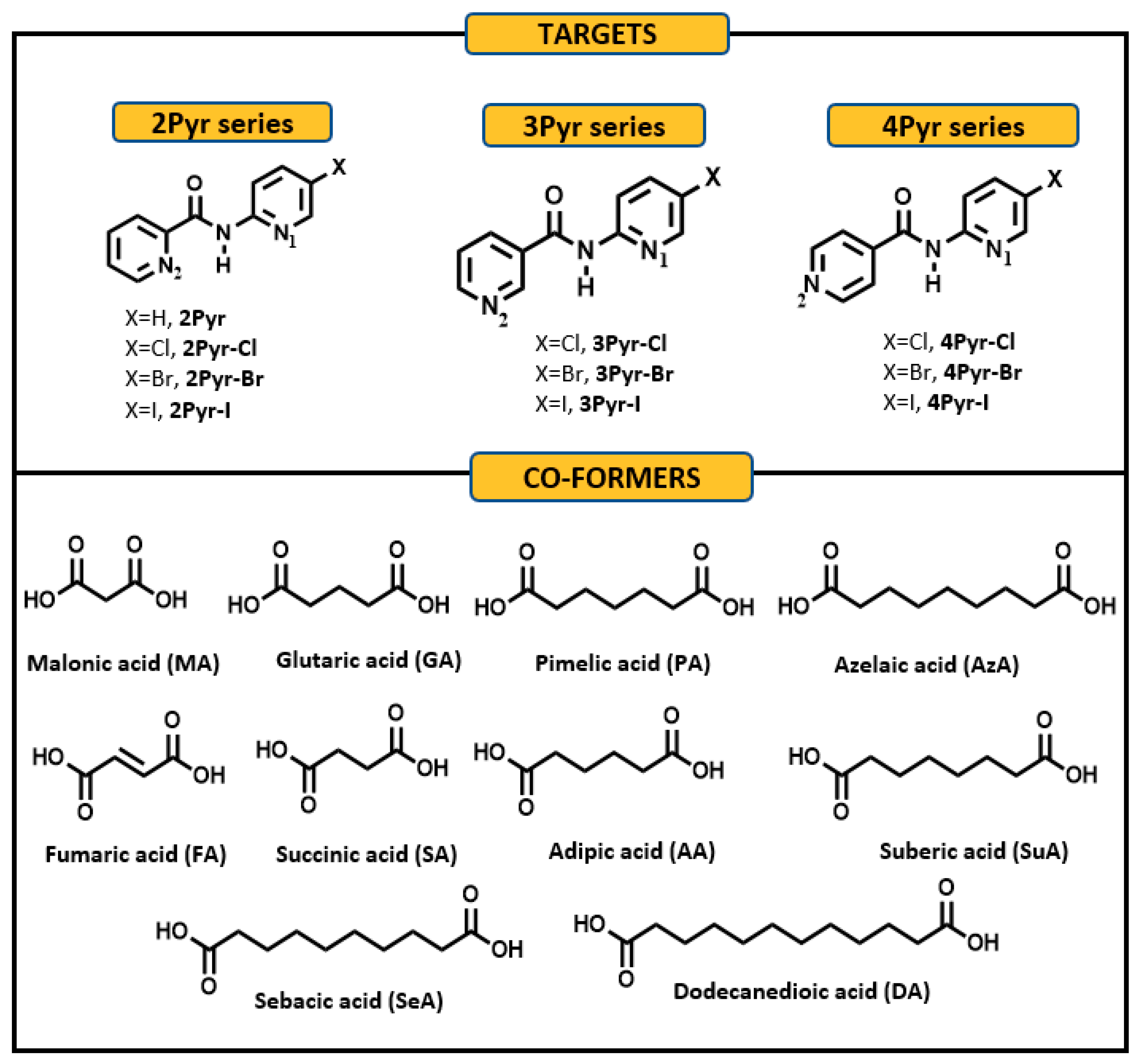
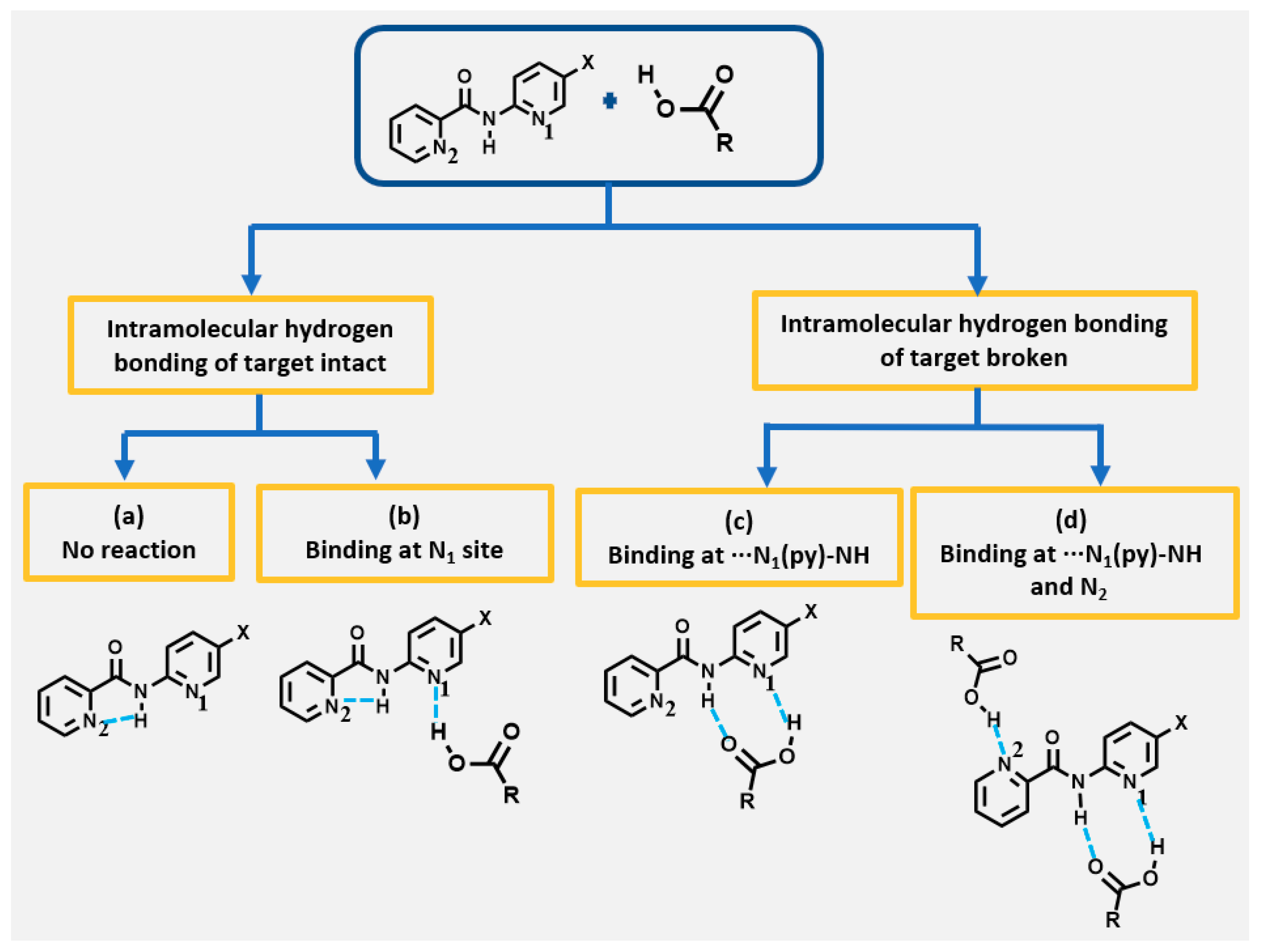



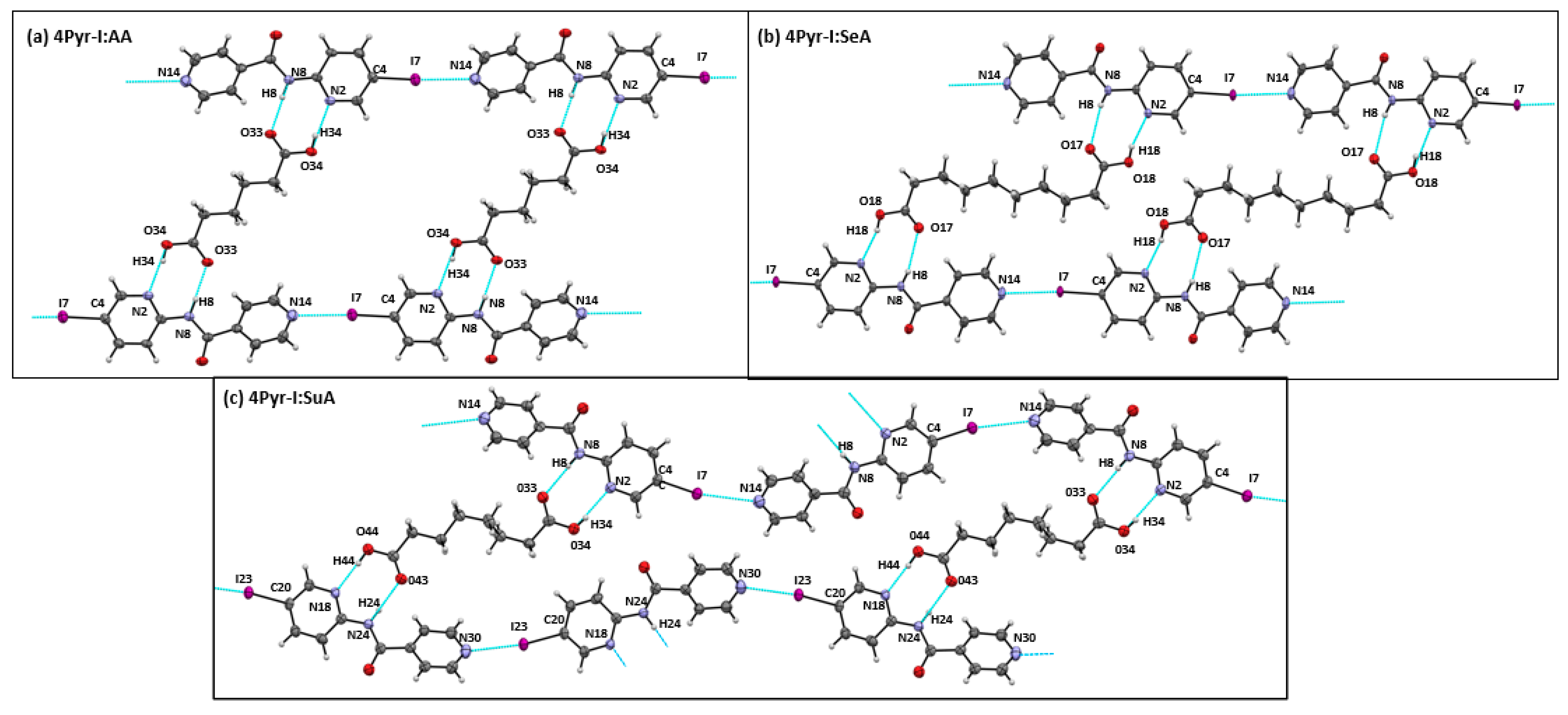
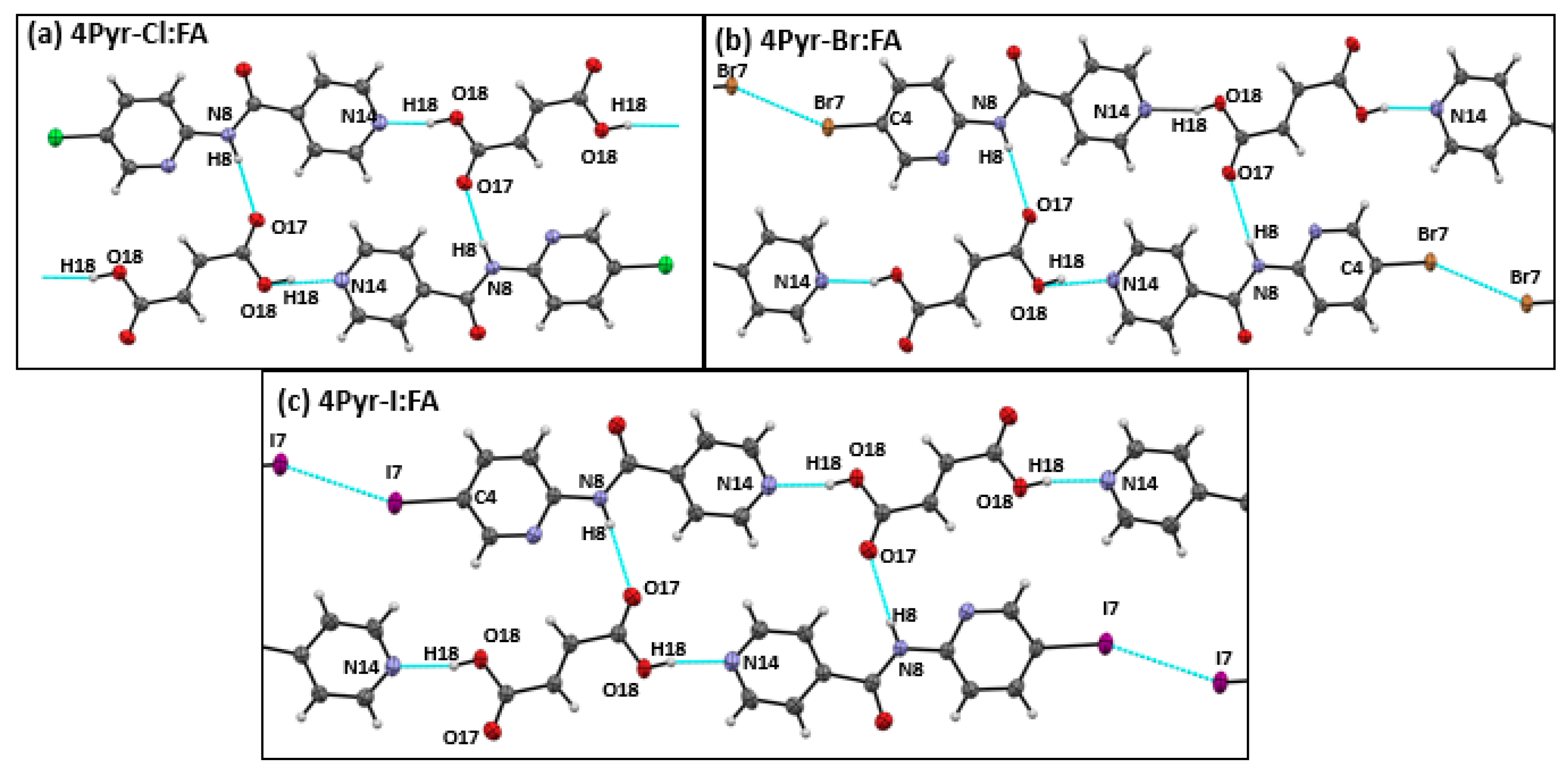
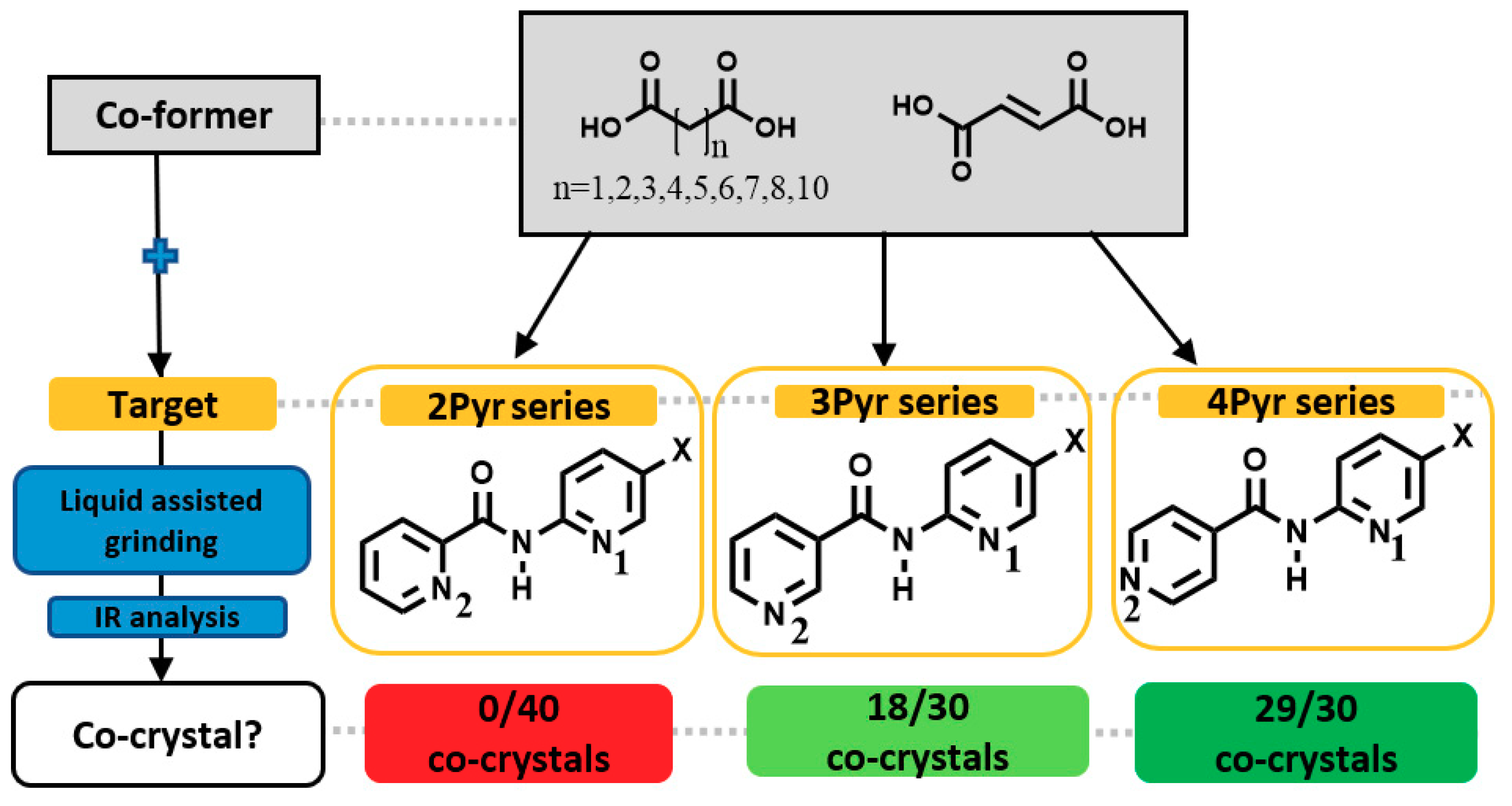
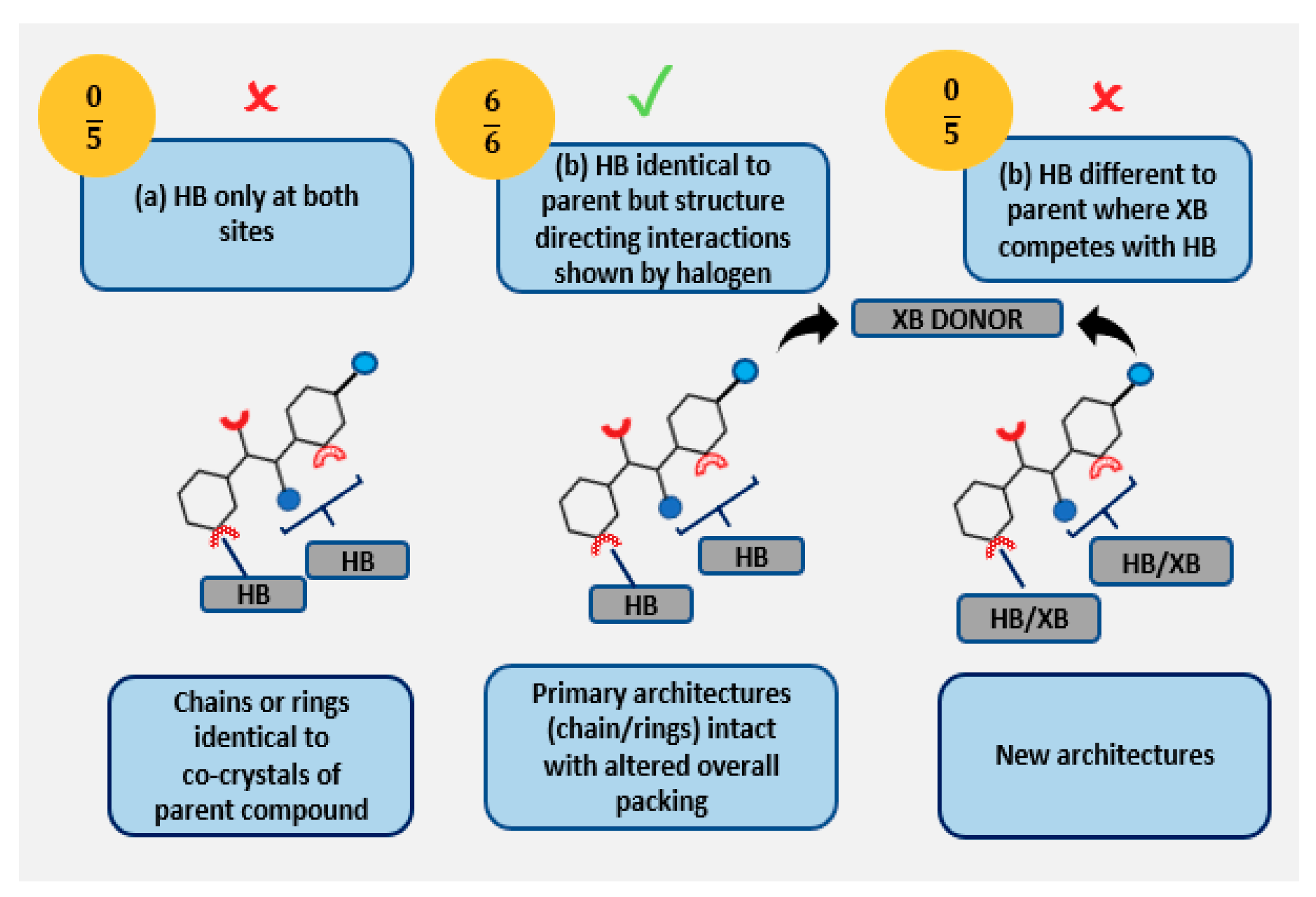
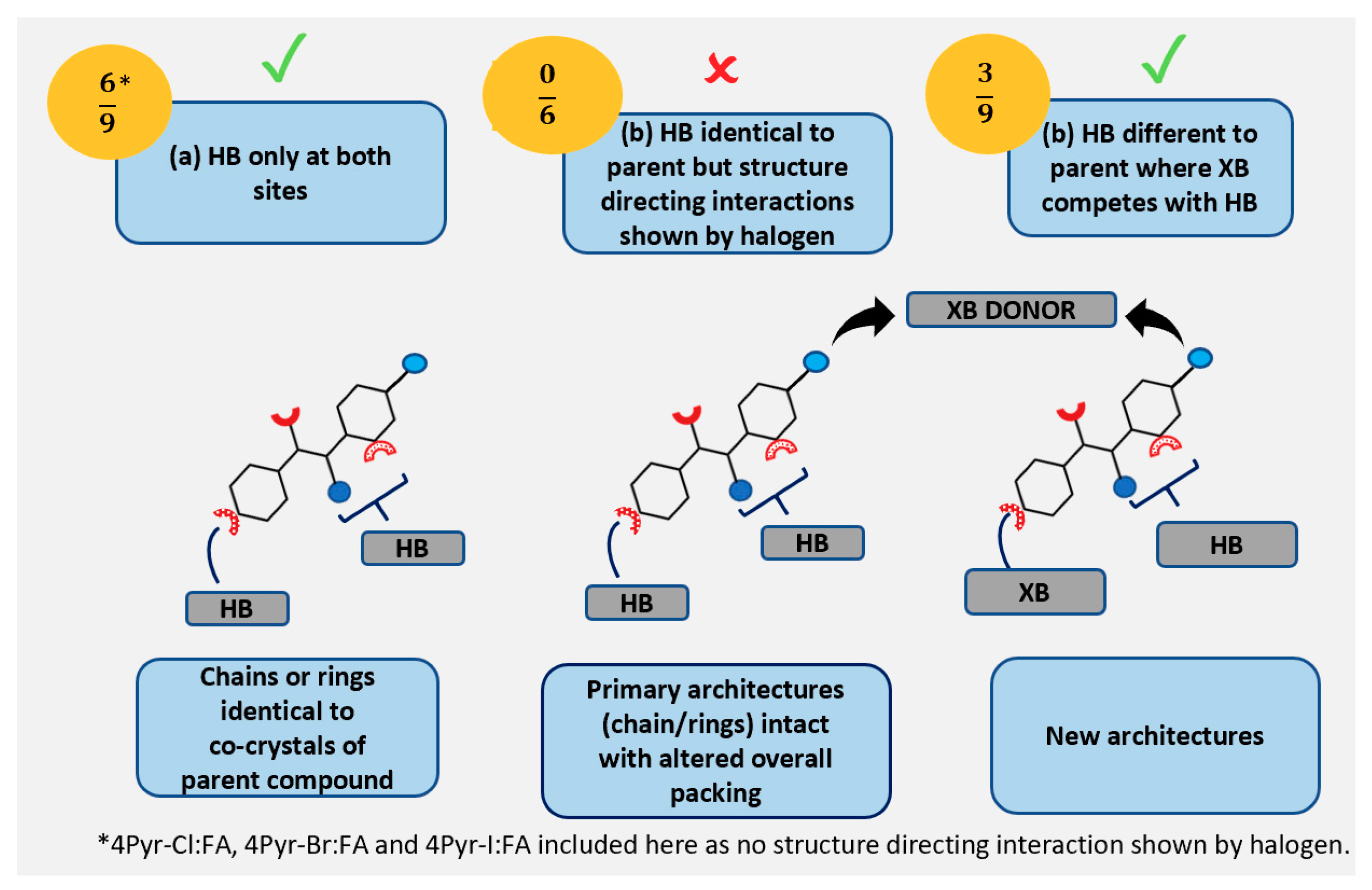

| Malonic Acid | Glutaric Acid | Pimelic Acid | Azelaic Acid | Fumaric Acid | Succinic Acid | Adipic Acid | Suberic Acid | Sebacic Acid | Dodecanedioic Acid | |
|---|---|---|---|---|---|---|---|---|---|---|
| 2Pyr | 🗴 | 🗴 | 🗴 | 🗴 | 🗴 | 🗴 | 🗴 | 🗴 | 🗴 | 🗴 |
| 2Pyr-Cl | 🗴 | 🗴 | 🗴 | 🗴 | 🗴 | 🗴 | 🗴 | 🗴 | 🗴 | 🗴 |
| 2Pyr-Br | 🗴 | 🗴 | 🗴 | 🗴 | 🗴 | 🗴 | 🗴 | 🗴 | 🗴 | 🗴 |
| 2Pyr-I | 🗴 | 🗴 | 🗴 | 🗴 | 🗴 | 🗴 | 🗴 | 🗴 | 🗴 | 🗴 |
| 3Pyr-Cl | ✓ | 🗴 | ✓ | 🗴 | 🗴 | ✓ | ✓ | ✓ | 🗴 | 🗴 |
| 3Pyr-Br | ✓ | ✓ | 🗴 | 🗴 | ✓ | ✓* | ✓ | ✓* | 🗴 | 🗴 |
| 3Pyr-I | ✓* | ✓ | 🗴 | 🗴 | ✓ | ✓ | ✓* | ✓* | ✓* | 🗴 |
| 4Pyr-Cl | ✓ | ✓ | ✓* | ✓ | ✓* | ✓ | ✓* | ✓ | ✓ | ✓ |
| 4Pyr-Br | ✓ | ✓ | ✓ | ✓ | ✓* | ✓ | ✓* | ✓ | ✓ | ✓ |
| 4Pyr-I | ✓ | ✓ | ✓ | ✓ | ✓* | ✓* | ✓* | ✓ | ✓* | 🗴 |
| Co-Crystal | Code | Solvent | Melting Point | Color and Morphology |
|---|---|---|---|---|
| (N-(5-bromopyridin-2-yl)nicotinamide) Succinic acid (1:1) | 3Pyr-Br:SA | Ethyl acetate: MeOH(1:1) | 185–187 °C | Colorless, Parallelepiped |
| (N-(5-bromopyridin-2-yl)nicotinamide) Suberic acid (1:1) | 3Pyr-Br:SuA | Ethyl acetate: MeOH(1:1) | 149–151 °C | Colorless, Rectangular |
| (N-(5-iodopyridin-2-yl)nicotinamide) Adipic acid (1:1) | 3Pyr-I:AA | Ethyl acetate | 163–165 °C | Yellow, Rectangular |
| (N-(5-iodopyridin-2-yl)nicotinamide) Suberic acid (1:1) | 3Pyr-I:SuA | Ethyl acetate | 148–150 °C | Colorless, Rectangular |
| (N-(5-iodopyridin-2-yl)nicotinamide) Sebacic acid (1:1) | 3Pyr-I:SeA | Ethyl acetate | 139–141 °C | Yellow, Rectangular |
| (N-(5-iodopyridin-2-yl)nicotinamide) Malonic acid (1:1) | 3Pyr-I:MA | Chloroform: MeOH(1:1) | 169–171 °C | Colorless, Rectangular |
| (N-(5-chloropyridin-2-yl)isonicotinamide) Adipic acid (1:1) | 4Pyr-Cl:AA | Ethyl acetate | 169–171 °C | Colorless, Rectangular |
| (N-(5-bromopyridin-2-yl)isonicotinamide) Adipic acid (1:1) | 4Pyr-Br:AA | Acetonitrile | 161–163 °C | Colorless, Rectangular |
| (N-(5-chloropyridin-2-yl)isonicotinamide) Pimelic acid (1:1) | 4Pyr-Cl:PA | Ethyl acetate | 163–165 °C | Colorless, Rectangular |
| (N-(5-iodopyridin-2-yl)isonicotinamide) Adipic acid (2:1) | 4Pyr-I:AA | Acetonitrile | 159–161 °C | Colorless, Chunk |
| (N-(5-iodopyridin-2-yl)isonicotinamide) Suberic acid (2:1) | 4Pyr-I:SuA | Ethyl acetate: MeOH(1:1) | 146–148 °C | Colorless, Rectangular |
| (N-(5-iodopyridin-2-yl)isonicotinamide) Subacic acid (2:1) | 4Pyr-I:SeA | Ethyl acetate | 147–149 °C | Colorless, Rhombus |
| (N-(5-chloropyridin-2-yl)isonicotinamide) Fumaric acid (1:1) | 4Pyr-Cl:FA | Ethyl acetate | 231–233 °C | Colorless, Irregular |
| (N-(5-bromopyridin-2-yl)isonicotinamide) Fumaric acid (1:1) | 4Pyr-Br:FA | Methanol | 240–242 °C | Colorless, Chunk |
| (N-(5-iodopyridin-2-yl)isonicotinamide) Fumaric acid (1:1) | 4Pyr-I:FA | Ethyl acetate | 237–239 °C | Colorless, Blocks |
| D-H/X··A | D/X···A (Å) | D-H/X···A (deg) | |
|---|---|---|---|
| 3Pyr-Br:SA | N8-H8···O17 | 3.071(3) | 167.(3) |
| O18-H18···N2 | 2.732(3) | 165.(5) | |
| O24-H24···N13 | 2.691(3) | 172.(4) | |
| C4-Br7···O18 | 3.191(2) | 158.56(8) | |
| 3Pyr-Br:SuA | N8-H8···O17 | 2.938(3) | 166.(3) |
| O18-H18···N2 | 2.692(3) | 175.(3) | |
| O28-H28···N13 | 2.754(3) | 177.(4) | |
| C4-Br7···O18 | 3.1979(19) | 159.79(8) | |
| 3Pyr-I:AA | N8-H8···O17 | 3.198(4) | 173.(4) |
| O18-H18···N2 | 2.668(4) | 171.(9) | |
| O26-H26···N13 | 2.683(4) | 169.(7) | |
| C4-I7···O18 | 3.186(3) | 155.15(11) | |
| 3Pyr-I:SuA | N8-H8···O27 | 2.970(5) | 170.(4 |
| O18-H18···N13 | 2.766(6) | 167.(7) | |
| O28-H28···N2 | 2.679(5) | 167.(5) | |
| C4-I7···O28 | 2.086(4) | 159.81(14) | |
| 3Pyr-I:SeA | O4B-H4B···N1D | 2.692(5) | 169.5 |
| N7D-H7D···O5B | 3.088(6) | 162.4(3) | |
| O2D-H2D ···N11D | 2.718(6) | 172.6 | |
| C3D-I1D···O4D | 3.227(4) | 151.4(2) | |
| O2B-H2B···N11B | 2.704(6) | 165.0 | |
| O4D-H4D···N1B | 2.660(5) | 171.2 | |
| N7B-H7B···O5D | 3.043(5) | 170.1(3) | |
| C3B-I1B···O4B | 3.229(4) | 152.5(2) | |
| O4A-H4A···N1C | 2.673(5) | 171.3 | |
| N7C-H7C···O5A | 3.043(6) | 168.0(3) | |
| O4C- H4C ···N11C | 2.706(6) | 172.2 | |
| C3C-I1C···O2C | 3.267(4) | 150.9(2) | |
| O2A-H2A···N11A | 2.705(6) | 165.2 | |
| O2C-H2C···N1A | 2.685(5) | 168 | |
| N7A-H7A···O3C | 3.068(6) | 169.2(3) | |
| C3A-I1A···O4A | 3.298(4) | 151.1(2) | |
| 04F-H4F···N1E | 2.661(6) | 169.4 | |
| N7E-H7E···05F | 3.050(6) | 161.8(3) | |
| O18- H18 ···N1F | 2.714(6) | 169.1 | |
| C3E-I1E···O4E | 3.201(4) | 152.4(2) | |
| O4E-H4E···N1F | 2.665(5) | 170.5 | |
| N7F-H7F···O5E | 3.068(5) | 162.4(3) | |
| O23-H23··· N11F | 2.661(6) | 169.4 | |
| C16-I1F···O4F | 3.229(4) | 152.5(2) | |
| 3Pyr-I:MA | N8-H8···O22 | 2.979(5) | 170.(5) |
| O18-H18···N13 | 2.634(5) | 165.(6) | |
| O23-H23···N2 | 2.689(5) | 173.(8) | |
| C4-I7···O17 | 3.231(4) | 156.63(14) | |
| C4-I7···O23 | 3.452(3) | 150.84(13) |
| D-H/I···A | D/I···A (Å) | D-H···A (deg) | |
|---|---|---|---|
| 4Pyr-Cl:AA | N8-H8···O25 | 2.7376(19 | 176(2) |
| O18-H18···N14 | 2.678(2) | 166(3) | |
| O26-H26···N2 | 2.7376(19) | 172(3) | |
| 4Pyr-Br:AA | N8-H8···O17 | 2.942(2) | 172(3) |
| O18-H18···N2 | 2.735(2) | 172(4) | |
| O26-H26···N14 | 2.683(3) | 172(4) | |
| 4Pyr-I:AA | N8-H8···O33 | 2.828(4) | 175.(5) |
| N24-H24···O38 | 2.874(4) | 167.(5) | |
| O34-H34···N2 | 2.689(4) | 170.(6) | |
| O39-H39··· N18 | 2.718(4) | 180.(10) | |
| C4-I7···N14 | 2.910(3) | 173.99(10) | |
| C20-I23···N30 | 2.938(4) | 177.38(13) | |
| 4Pyr-I:SuA | N8-H8···O33 | 2.877(6) | 173.(5) |
| N24-H24···O43 | 2.814(6) | 167.(6) | |
| O34-H34···N2 | 2.765(6) | 164.(16) | |
| O44-H44···N18 | 2.738(6) | 172.(7) | |
| C4-I7···N14 | 3.140(5) | 168.28(19) | |
| C4-I23···N30 | 2.931(5) | 170.09(18) | |
| 4Pyr-I:SeA | N8-H8···O17 | 3.104(3) | 166.(4) |
| O18-H18···N2 | 2.697(3) | 160.(6) | |
| C4-I7···N14 | 2.910(3) | 173.99(10) | |
| 4Pyr-Cl:PA | N8-H8···O26 | 2.973(3) | 174(3) |
| O18-H18···N14 | 2.705(3) | 174(4) | |
| O27-H27···N2 | 2.737(3) | 169(3) | |
| 4Pyr-Cl:FA | N8-H8···O17 | 3.0940(15) | 175.2(18) |
| O18-H18···N14 | 2.6129(16) | 168(2) | |
| 4Pyr-Br:FA | N8-H8···O17 | 3.094(2) | 176.(3) |
| O18-H18···N14 | 2.619(2) | 162.1 | |
| C4-Br7··· Br7 | 3.6187(5) | 155.69(7) | |
| 4Pyr-I:FA | N8-H8···O17 | 3.118(4) | 175.(3) |
| O18-H18···N14 | 2.653(3) | 167.(4) | |
| C4-I7··· I7 | 3.6478(7) | 157.54(8) |
Publisher’s Note: MDPI stays neutral with regard to jurisdictional claims in published maps and institutional affiliations. |
© 2021 by the authors. Licensee MDPI, Basel, Switzerland. This article is an open access article distributed under the terms and conditions of the Creative Commons Attribution (CC BY) license (http://creativecommons.org/licenses/by/4.0/).
Share and Cite
Abeysekera, A.M.; Sinha, A.S.; Aakeroy, C.B. The Impact of Halogen Substituents on the Synthesis and Structure of Co-Crystals of Pyridine Amides. Molecules 2021, 26, 1147. https://doi.org/10.3390/molecules26041147
Abeysekera AM, Sinha AS, Aakeroy CB. The Impact of Halogen Substituents on the Synthesis and Structure of Co-Crystals of Pyridine Amides. Molecules. 2021; 26(4):1147. https://doi.org/10.3390/molecules26041147
Chicago/Turabian StyleAbeysekera, Amila M., Abhijeet S. Sinha, and Christer B. Aakeroy. 2021. "The Impact of Halogen Substituents on the Synthesis and Structure of Co-Crystals of Pyridine Amides" Molecules 26, no. 4: 1147. https://doi.org/10.3390/molecules26041147
APA StyleAbeysekera, A. M., Sinha, A. S., & Aakeroy, C. B. (2021). The Impact of Halogen Substituents on the Synthesis and Structure of Co-Crystals of Pyridine Amides. Molecules, 26(4), 1147. https://doi.org/10.3390/molecules26041147






